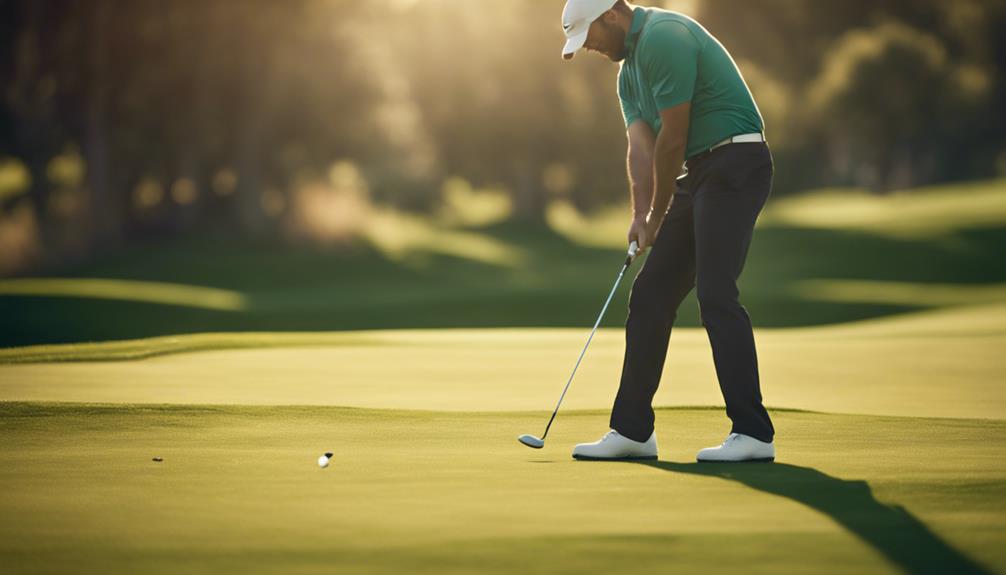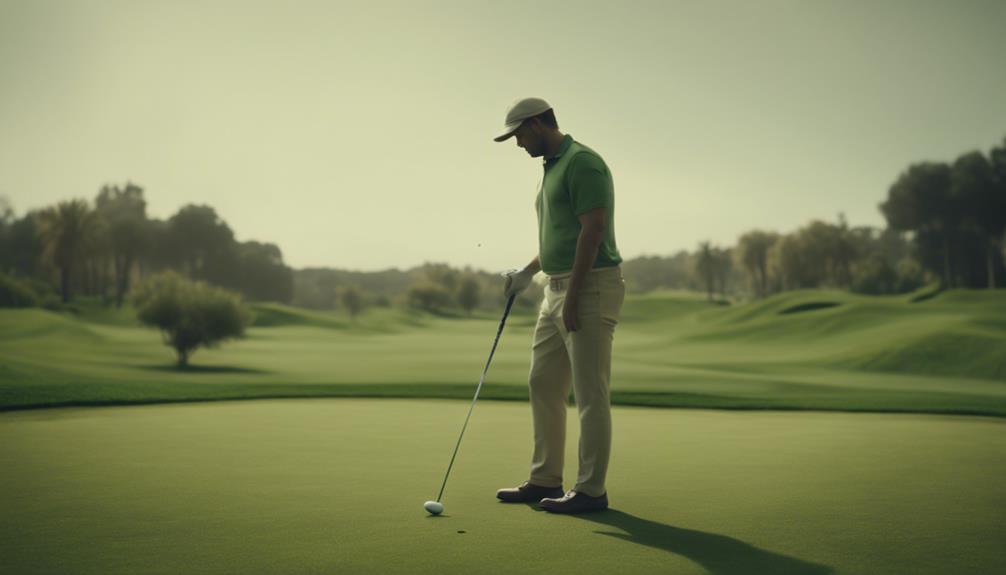- 7 Top Flite Golf Clubs XL for Improved Performance - September 28, 2024
- Top Flite Golf Clubs: Top 5 Reasons to Choose Them - September 28, 2024
- Top 3 Golf Club Fitters for a Perfect Swing - September 28, 2024
When hitting out of thick rough, you'll want to choose clubs that provide a higher trajectory, more forgiveness, and a greater ability to glide through the grass. Consider reaching for a 7 iron, 9 iron, hybrid, or wedge, as they're designed to help you escape dense vegetation. Hybrid clubs, in particular, offer enhanced forgiveness and a higher likelihood of solid contact, making them ideal for golfers with slower swing speeds or less consistent ball-striking. By understanding the characteristics of each club and how to adjust your swing accordingly, you'll be well on your way to mastering rough shots and getting back on track – and there's more to learn to take your game to the next level.
Key Takeaways
- Hybrid clubs are ideal for escaping thick rough due to their ability to glide through the grass and provide enhanced forgiveness.
- 7 iron and 9 iron offer a higher trajectory and more forgiveness than longer irons, making them viable options for rough shots.
- Wedge is the best option if the ball is buried, with its high angle of attack and ability to dig the ball out of the rough.
- Sand wedge or gap wedge can provide a more predictable outcome due to their higher bounce angle and ability to glide through the grass.
- Hybrid clubs with a larger sweet spot, such as the 4 hybrid, increase the chances of making solid contact from the rough.
Club Selection for Thick Rough
When faced with thick rough, you'll want to choose a club that can effectively escape the dense grass and get the ball back to the fairway, and a 7 iron, 9 iron, hybrid, or wedge are all viable options.
Each of these clubs offers a unique advantage in this situation. The 7 iron and 9 iron provide a higher trajectory and more forgiveness than longer irons, making them a good choice for getting the ball back to the fairway.
A hybrid club, on the other hand, is designed to glide through the grass more easily than an iron, making it a great option for thick rough.
If the ball is buried, a wedge is your best bet. With its high angle of attack, a wedge can lift the ball quickly out of the rough.
Consider using a sand wedge or gap wedge for a more predictable outcome, as they're designed for high-angle shots and can handle thick grass better than other clubs.
Factors Affecting Shot Outcome
When you're hitting out of the rough, you need to take into account the factors that affect your shot outcome.
You'll want to think about how the type of rough, the lie of the ball, and the distance to the green will impact your clubhead speed and angle of attack.
Clubhead Speed Impact
Hitting out of the rough demands adjustments to your swing tempo and technique, as the dense vegetation reduces clubhead speed by 10-20%, substantially impacting shot outcome.
The density and height of the rough also play a significant role, with thicker and taller rough resulting in slower clubhead speeds.
Your ball position in the rough affects your swing plane and angle of attack, which in turn influence clubhead speed and shot outcome.
You'll need to adapt to the type of grass you're playing from, as thicker and more dense grasses like Bermuda and zoysia reduce clubhead speed more than thinner grasses like bent and rye.
A 10-20% reduction in clubhead speed can result in a 20-40 yard loss of distance, making accurate club selection and swing adjustments critical when playing from the rough.
To compensate, you'll need to slow down your swing tempo and adjust your technique to maintain a consistent clubhead speed.
Angle of Attack
With the rough's dense vegetation dictating a steeper angle of attack, you'll need to adjust your swing to guarantee the clubhead strikes the ball first, rather than the surrounding grass, to achieve a decent shot outcome. This is especially vital when dealing with a buried lie, where the ball is nestled deep in the thick rough.
To compensate for the increased angle of attack, you may need to use a deeper club, such as a hybrid or fairway wood, to make certain the clubhead can reach the ball. The following table illustrates the ideal angle of attack for different types of lies:
| Lie Type | Ideal Angle of Attack | Club Selection |
|---|---|---|
| Fluffy Lie | Shallow (10-15°) | Wedge or 9-iron |
| Normal Lie | Moderate (15-20°) | 7-iron to hybrid |
| Buried Lie | Steep (20-25°) | Hybrid or fairway wood
Lie of the Ball Considerations

You must carefully evaluate the lie of the ball in the rough, as it substantially impacts your clubhead speed, swing plane, and angle of attack.
When the ball sits in thick rough, you'll need to adjust your swing to compensate for the reduced clubhead speed, which can be 10-20% slower than shots from the fairway.
Ball position is also vital, as it affects your swing plane and angle of attack. If the ball is sitting up, you'll need to adjust your angle of attack to avoid hitting the rough first. Conversely, if it's buried, you'll need to steepen your angle of attack to dig it out.
Proper clubface alignment is essential, as misalignment can lead to poor contact and compound the initial mistake.
Consider the height and density of the rough, as thicker or taller rough may require more loft and a steeper angle of attack.
Distance and Trajectory Control
When you're hitting out of the rough, controlling distance and trajectory is essential to getting back on track.
You'll want to focus on achieving higher launch angles to clear the rough and maintain a consistent carry distance.
Higher Launch Angles
Opting for a club that produces a higher launch angle is essential for escaping the rough, as this trajectory control allows you to clear the dense foliage and get back on track.
When faced with a shot from 180 yards out in the rough, consider reaching for a 5 iron or 4 hybrid, as they provide a higher launch angle and more distance control.
If you prefer a club with loft, a hybrid or fairway wood like the Callaway X Hot can help you achieve a higher launch angle and escape thick rough.
Alternatively, a choked-up UDI 3i can also provide a higher launch angle and more control over distance.
Avoid using a 19° hybrid, as its lower launch angle makes it less effective for shots from thick rough.
For shots between 170-200 yards out, the Callaway Epic Flash 7wd with a PX HZRDUS Black 85g, 6.5 (x flex) Tour Issue shaft is a popular choice, thanks to its higher launch angle and forgiveness.
Consistent Carry Distance
Its consistent carry distance and trajectory control make a club like the TaylorMade P790 UDI an ideal choice for tackling the rough, as it allows you to gauge your shot's distance and height with precision.
When you're stuck in the thick stuff, you need a club that can deliver a consistent carry distance, shot after shot.
This is where the Tour Edge Exotics CBX 119 shines, with its advanced engineering and design that helps you maintain a consistent carry distance, even when the ball is positioned back in your stance.
By positioning the ball back in your stance, you'll be able to go long and high, with a more controlled trajectory.
This is especially important when hitting out of the rough, as you need to be able to carry the ball far enough to clear any obstacles and get back onto the fairway.
With the right club, you'll be able to achieve a consistent carry distance, giving you the confidence to take on even the toughest shots.
Wedge Play From Light Rough

To escape light rough, you'll often find that a wedge is the best club choice, as it provides the necessary loft and control to land the ball on the green.
When playing from light rough, position the ball slightly back in your stance to help the clubhead cut through the grass more easily, promoting a cleaner strike. For these shots, adopt a more vertical swing with a steeper angle of attack to help the clubhead punch through the grass and get the ball out quickly.
Using a wedge with a higher bounce angle, such as the Titleist Vokey SM, can help the clubhead glide through the light rough more smoothly, reducing the risk of digging in or catching the grass.
Focus on making a consistent swing, keeping the clubface square to the target line, and avoiding any twisting or closing of the clubface. This will help you maintain control and consistency when hitting wedges from light rough.
Hybrid Clubs for Forgiveness
When you're faced with a shot from thicker, more challenging rough, hybrid clubs emerge as a reliable option, offering enhanced forgiveness and a higher likelihood of solid contact. Compared to traditional longer irons, hybrid clubs are designed to provide more forgiveness, making them an ideal choice for shots from the rough.
Hybrid clubs have a larger sweet spot, which increases the chances of making solid contact with the ball, even when it's sitting in thick grass.
They are typically easier to hit from the rough than traditional long irons, especially for golfers with slower swing speeds or less consistent ball-striking.
The more rounded sole and higher center of gravity of hybrid clubs allow them to glide through the rough more easily, reducing the likelihood of the club digging into the ground.
The forgiveness of hybrid clubs can help to reduce the severity of wayward shots, making them a valuable tool for golfers of all skill levels when playing from the rough.
Mastering Rough Shots With Practice

Mastering rough shots requires deliberate practice from a variety of lies, focusing on developing a consistent pre-shot routine and refining your swing technique to overcome the challenges of thick and thin rough. To improve your skills, practice hitting from different types of rough, aiming to make solid contact rather than focusing on distance or direction.
| Rough Type | Swing Adjustment | Clubface Alignment |
|---|---|---|
| Thick Rough | Steeper angle of attack, more vertical swing plane | Face a little closed, aiming directly at the target line |
| Thin Rough | Slightly shallower angle of attack, more controlled swing tempo | Clubface square to the target line, with a slight bias towards the rough side |
| Mixed Rough | Experiment with different clubs and swing styles to find what works best | Adjust grip pressure and clubface alignment based on the specific lie and club selection |
Frequently Asked Questions
What Clubs Can You Hit Out of Rough?
When facing a shot from the rough, you can opt for wedges for high-lofted escapes, rough-taming hybrids, long irons for distance, or fairway clubs for a more forgiving strike, depending on the rough's density and your club selection expertise.
How to Hit a Golf Shot Out of the Rough?
"As you venture into the fray like a medieval knight, remember to adjust your ball position forward, slow your swing tempo, and focus mentally on a smooth escape from rough lies; practice these tips to conquer the unruly rough."
How to Hit Irons Out of Deep Rough?
When you're hitting irons out of deep rough, focus on adjusting rough angles by opening the club face, selecting the right iron, and controlling swing speed. Position the ball back in your stance and experiment with different club face angles to master this challenging shot.
Why Can't I Hit Out of the Rough?
You're struggling to escape the rough because you're not addressing the root causes: poor lie evaluation, swing flaws, incorrect club selection, and improper ball position, all leading to devastating angle issues that ruin your shots.
Conclusion
You've made it this far, and yet, you're still stuck in the rough.
Ironically, that's exactly where you'll be again if you don't master the art of escaping it.
The good news is that with the right clubs and a solid understanding of technique, you can turn a potentially disastrous shot into a brilliant recovery.
So, don't get too comfortable in the rough – use it as an opportunity to prove your skills and emerge victorious.




